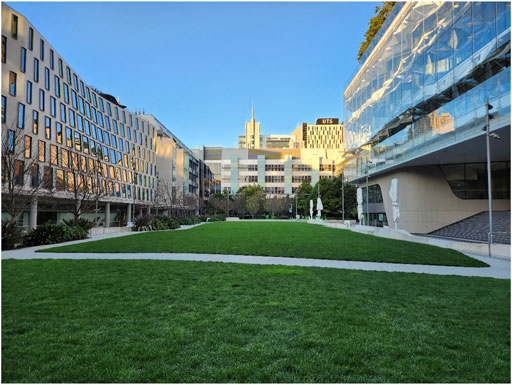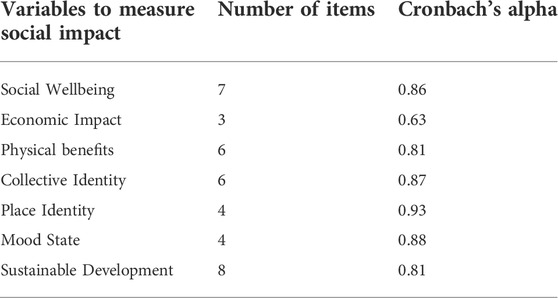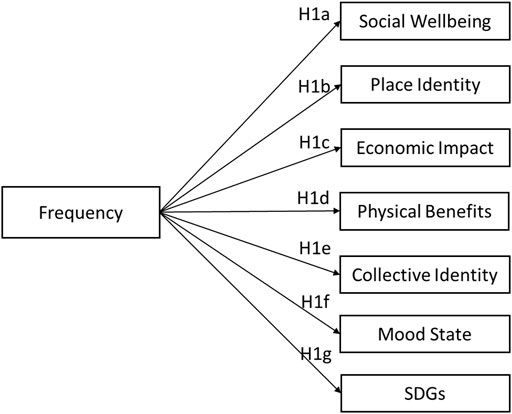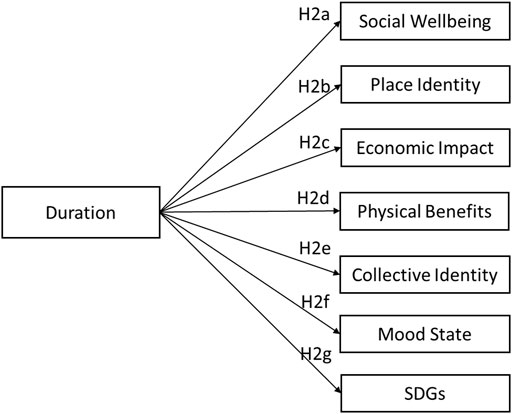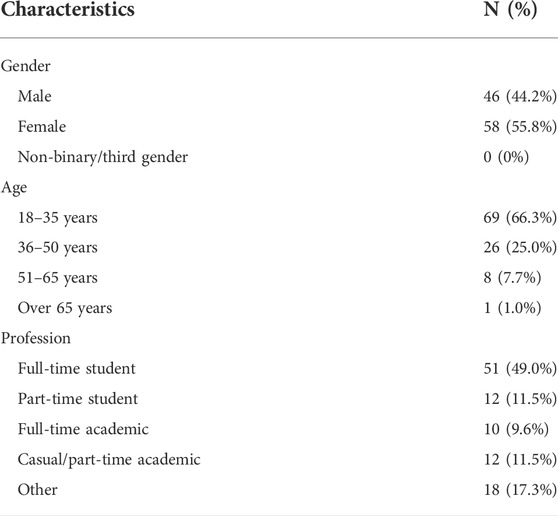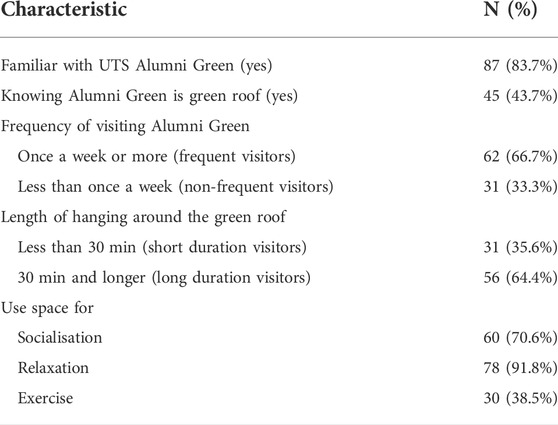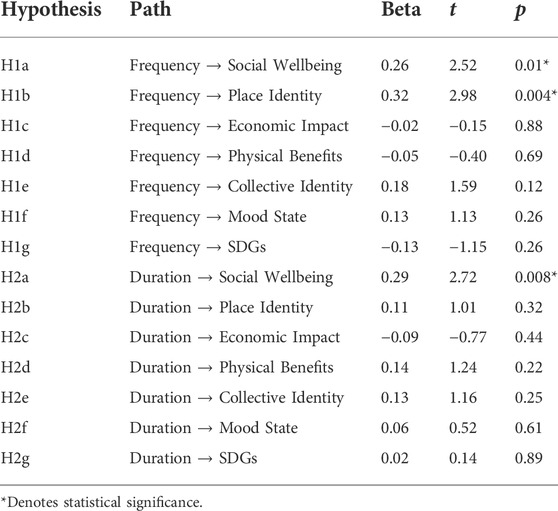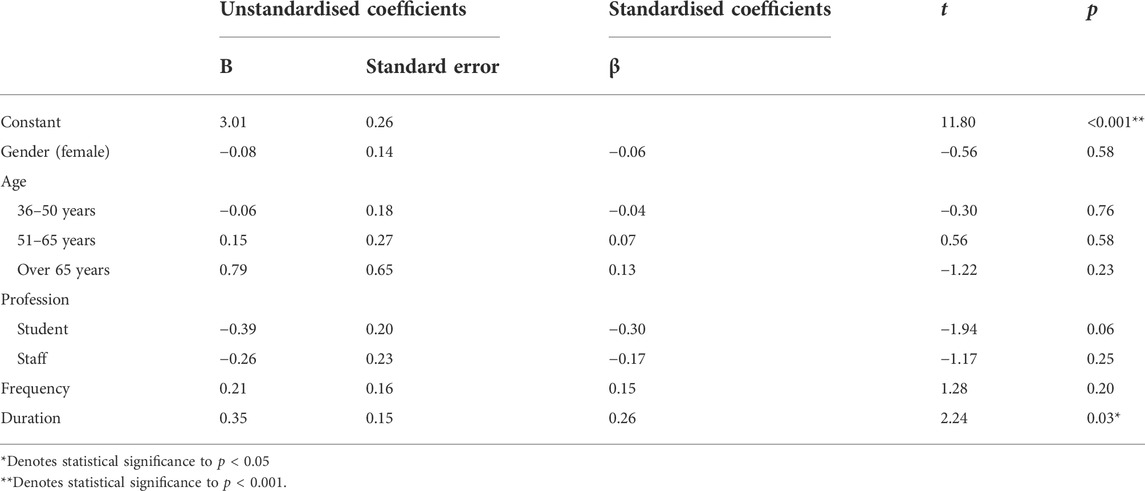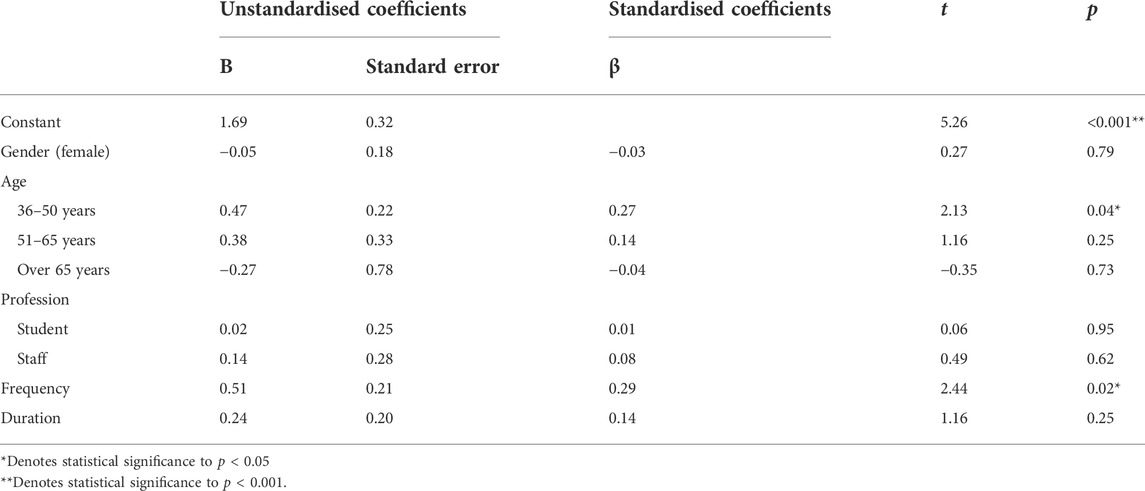- 1School of Business, Western Sydney University, Sydney, NSW, Australia
- 2International School of Business, University of Economics HCMC, Ho Chi Minh City, Vietnam
- 3Institute for Sustainable Futures, University of Technology Sydney, Sydney, NSW, Australia
- 4School of Built Environment, University of Technology Sydney, Sydney, NSW, Australia
Green roofs are recognised as contributing towards building-related energy efficiency. Since roofs account for 20–25% of all urban surface areas, it is not surprising that such a green system can offer a sustainable solution to decreased energy consumption. The current literature on green roofs mostly focuses on the eco-benefits of such structures. A handful of research papers1 have theorised that as green roofs become more prevalent, there will be associated social outcomes for an urban community. However, empirical work in this space is minimal. This research addresses this gap and contributes to the literature by providing insights into city dwellers’ social experiences when using a green roof space. This study identified a green roof space in central Sydney, Australia: the Alumni Green at the University of Technology Sydney. The roof, containing a garden, a concrete open space and a raised grass area amounting to 1,200 m2, is above parts of the university’s library and classrooms, and is easily accessible by staff, students, and members of the public. Two members of the research team conducted surveys on site. Some green-roof users were also contacted via email. Over 128 individuals began the survey, although after removing responses that were incomplete or containing errors, 104 responses remained. The findings revealed that users, most commonly, relaxed or socialised on the green roof, with exercise a far less frequent activity. Further, those who frequented the green roof once a week or more reported significantly greater social well-being and attachment to place than those who visited less. Likewise, those who visited the green roof for periods of 30 min or more also reported greater social wellbeing. There were no significant differences between frequency and length of use and users’ perspectives on the green roof’s economic, physical, collective identity or environmental impacts. These present findings have implications for urban and landscape designers, as they reveal that green roofs have similar social and place-attachment benefits to those observed of green spaces in the literature. Given that green roofs can fit in places that parks or other open spaces often cannot, their implementation should be encouraged to promote social well-being and place attachment.
1 Introduction
Green roofs, those with vegetation planted on top of a growth medium (substrate), have been observed to provide a number of benefits, including environmental, aesthetical and economic (Vijayaraghavan, 2016). For instance, green roofs have been found to contribute towards building-related energy efficiency, to hold moisture and minimise runoff, and to buffer acidic rain and theoretically retain pollutants thereby producing good quality stormwater (Hashemi et al., 2015). Researchers have also highlighted the benefits of a green roof in noise and air pollution reduction (Van Renterghem and Botteldooren, 2011). While numerous research studies have looked at such environmental and economic benefits of green roofs, few have investigated the impacts of green roofs on society and the immediate community (Manso et al., 2021). In fact, a recent review found that it is difficult to quantitatively determine the social impacts of green roofs (Manso et al., 2021).
In this study, the researchers aim to address this gap by employing an online survey to understand participants’ perceptions of the impact of green roofs. The authors refer to the concept of biophilia (Wilson, 2017) to argue there is a proposed link between green roofs and social impact. For instance, the biophilia hypothesis proposes that there is an inherent connection between humans and nature, and that contact with nature plays a fundamental role in humans’ social, physical and mental well-being (Grinde and Patil, 2009).
Certainly, research on green spaces, such as parks, has tended to confirm the biophilia hypothesis. Green spaces have been observed to have numerous social benefits for those who use and interact with them. For instance, users of green spaces have been observed to have improved social wellbeing (Ward Thompson et al., 2016; Holt et al., 2019), physical outcomes (Gigliotti and Jarrott, 2005; Orr and Wilkinson, 2017; Harris and Trauth, 2020), and mood (Fjeld et al., 1998; Gray, 2017). Beyond this, green spaces also create greater collective identity (Zhou et al., 2021), attachment to place (Liu et al., 2022), have economic benefits on the surrounding area (Keniger et al., 2013) and advance progression towards addressing the sustainable development goals (Manso et al., 2021). Yet, individuals use green roofs differently to green spaces, as they are often smaller and more difficult to access or undertake exercise on (Manso et al., 2021). Whether these biophilic benefits are replicated for users of green roofs remains to be seen.
The authors propose a social impact framework that can be used to investigate the effects of green roofs on society and the local community. The framework consists of multiple outcomes: 1) social wellbeing; 2) economic activity in the area; 3) physical benefits; 4) collective and place identity; 5) mood state; and 6) sustainable development. The overall aim of the paper is to examine the social impact of a green roof. More specifically, the research questions are:
RQ1:. Does the frequency of use (of the green roof) influence any of the social impact variables?
RQ2:. Does the visitors’ duration of visit (at the green roof) influence any of the social impact variables?
RQ3:. Of the social impact variables that are influenced by frequency or duration, does this influence remain once the role of sociodemographic characteristics in predicting the social impact variable are taken into account?
1.1 Literature review
In many cases, green roofs are inaccessible to public due to space (Williams et al., 2019) and design issues (Ali Ariff et al., 2022). Green roofs are primarily constructed with an engineering or environmental perspective. Thus, it is not surprising that green roofs are usually recognized for aesthetics, energy efficiency, and contribution to general environment.
However, if green roofs are designed so local community members can actively use the space, various economic, social and health benefits can be realised (Tabatabaee et al., 2022). Researchers have also provided conceptual arguments relating to psychological benefits (Williams et al., 2019) associated with such building features. In recent studies, green roofs are examined for social and recreational activities (Bianchini and Hewage, 2012). It has been suggested that if community members are made aware of the potential advantages of such spaces, they would support their installation. General attitudes towards green roofs have been found to be positive (Jungels et al., 2013).
While the existing literature recognises the benefits of green roofs beyond obvious environment-related outcomes, few studies have adopted a comprehensive framework to adequately investigate the impact of green roofs on the society and the immediate community. In this study, the researchers aim to employ the social impact framework, as recommended for green innovation studies (Nguyen Dang et al., 2022). To accurately measure the impact of green roofs on nearby communities, the study will look at: environmental impact, health impact, economic impact, impact on social and human capital, and any effects on people’s collective as well as place-related identities.
2 Materials and methods
2.1 Context
This study identified an appropriate green roof space in a high-density location in central Sydney, Australia. The location was selected as it was designed for use by members of the local community. The green roof is referred to as ‘The Alumni Green’ at the University of Technology Sydney (UTS). The roof, containing a garden, a paved open space and a raised grass area amounting to 1,200 m2, is above parts of the university’s library and classrooms, and is easily accessible by staff, students, and members of the public outside the university (refer to Figure 1). Unlike a traditional sandstone university campus nearby, the UTS comprises of a string of buildings that are embedded in the busy Central Business District (CBD) of Sydney.
2.2 Sample and data collection
A cross-sectional sample of people in or near the green roof (i.e., the Alumni Green), consisting mostly of students and staff, was conducted (N = 104). Participants were recruited using two methods: 1) emails were sent to the researchers’ contacts at the University of Technology Sydney who would have interacted with the green roof and could be potential participants (N = 61); and 2) two members of the research team used the intercept technique by randomly approaching passers-by and visitors to the green roof (N = 67).
A total of 128 participants began the survey, although 24 responses were removed due to incompletion or error and missing responses. The survey was conducted online via Qualtrics from May to July 2022. A major section of the survey consisted of structured scale items. However, survey respondents were encouraged to articulate their opinions about the green roof, as well.
Ethical approval was obtained from the Western Sydney University’s Human Research Ethics Committee. Consent was obtained by having participants read the participant information sheet and having them agree to partake in the survey by clicking to begin.
2.3 Measurement
2.3.1 Sociodemographic characteristics
Sociodemographic characteristics have been observed to predict the way people interact with and use green spaces (e.g., Holt et al., 2019). In this study, age, gender, and profession were measured. These were all recorded using ordinal scales. For instance, age (18–35, 36–50, 51–65, and over 65 years) and gender (male, female, non-binary/third gender, prefer not to say) were divided into four categories, whilst profession was divided into five (full-time student, part-time student, full-time academic, casual/part-time academic, and other). For the purposes of this analysis, gender was converted into a dummy variable as participants only selected male or female in their responses, as was profession (student or staff/other).
2.3.2 Usage of green roofs
Participants’ interactions with the green roof were measured by asking how frequently they visited the space and for how long, whether they knew it was a green roof, how easy it was for them to access the green roof, what activities they undertook on the green roof, and how attractive they found the amenities. For the data analytical purposes of this study, these variables were recorded as dummy variables. For instance, participants’ frequency of visit was recorded through two categories: those who visited less than once a week and those who visited weekly or more often. Likewise, length of visit was also recorded across two categories: those who visited for 30 min or more and those who visited less than 30 min. Activities undertaken at the green roof were recorded across three dummy variables where participants indicated whether they used the roof for: socialisation (yes or no), relaxation (yes or no) and exercise (yes or no).
2.3.3 Social impact
To examine the social impact of the green roof, a social impact framework was constructed consisting of seven different variables: social wellbeing, economic impact, physical benefits, collective identity, place identity, mood state and sustainable development. Each variable consisted of several items measured on a scale of 1 (strongly disagree) to 5 (strongly agree). Scores across each item were aggregated and then averaged to provide an overall score for each variable of the framework. Low scores for each variable indicated lower levels of that outcome. For instance, a lower score for social wellbeing indicates the participant perceived the impact of the green roof on social wellbeing was minimal. All measures were reliable as demonstrated by the Cronbach’s Alpha scores (refer to Table 1).
Social wellbeing was recorded through a seven-item construct developed from Finlay et al. (2015)’s research on aspects of green and blue spaces that shape social interactions. The seven items were: opportunity to meet friends/colleagues; contributes to community building; provides social interaction; reduces social isolation; brings happiness at watching others; provides an opportunity to watch/interact with pets/nature; boosts feelings of safety, security and accessibility.
The construct for participants’ perspectives of the economic impact of the green roof consisted of three items developed by this research team. These three items emerged from questions relating to participants’ perceptions of the green roof’s impact on the value of adjoining properties, energy costs, and the generation of economic activity.
Physical benefits were measured across six items. Each item consisted of a question referring to respondents’ perception of the green roof contributing to physical strength, increased agility, better posture, improved circulation, improved respiration, and metabolism.
The construct for collective identity consisted of six items modified from Thomas et al. (2016)’s construct for group identification. The six items used to measure participants’ identification with other people using the green roof were: identifying with other users; feeling committed to other users; seeing being a part of the crowd as important; having a lot in common with other users; feeling part of the community; and feeling loyal to the group of people using the roof.
The scale for place identity was developed from Budruk et al. (2009). Across four items, participants were asked to what extent the space means a lot to them, they are attached to the space, they strongly identify the space, and feel no commitment/attachment to the space.
Mood state was measured using a shortened version of the Profile of Mood States, developed by McNair et al. (1992). Across four items, participants were asked to what extent the green roof assists users with relaxing, reducing tension, reducing fatigue, and increased vigour.
An eight-item scale was developed to measure participants’ opinion regarding the role of green roof in meeting some of the United Nations Sustainable Development Goals (SDGs). The eight items emerged from questions asking the extent to which participants thought the green roof: encourages a healthy lifestyle; is accessible to people of all ages; is a safe and inclusive space; encourages them to come into and spend time at the university; prompts them to think about nature and sustainable development; minimises the impacts of climate change; promotes action that combats climate change; and protects and maintains biodiversity.
2.4 Data analysis
Using SPSS, the dataset was cleaned. To analyse the effect of the green roof on the various outcome measures (social wellbeing, economic impact, physical benefits, collective identity, place identity, mood state and SDGs), a range of statistical analyses were conducted in order to examine the role of sociodemographic characteristics and green roof interactions in shaping these outcomes.
First, to test RQ1, linear regressions were conducted as outlined in Figure 2. That is, regressions were conducted to test whether the frequency at which a user visited the green roof influenced each variable of the social impact framework: social wellbeing (H1a); place identity (H1b); economic impact (H1c); physical benefits (H1d); collective identity (H1e); mood state (H1f); and SDGs (H1g). Second, for RQ2, duration of stay at the green roof is hypothesised to be linked with variables meaning social impact (H2a-g) (refer to Figure 3).
Third, to test RQ3 and explore whether the social impact variables that were found to be influenced by frequency and duration in the linear regressions still remain so when taking into account sociodemographic characteristics, multiple linear regressions were conducted for each variable of the social impact framework. In each of these regressions, gender, age, profession, duration and frequency were used as predictors of the variable.
3 Results
3.1 Sample characteristics
A summary of the sample’s demographic characteristics is provided in Table 2. Of the 104 participants, the majority were female (55.8%). The largest age group consisted of those between the ages of 18 and 35 (66.3%). The next biggest age group was those aged 36–50 (25.0%), while those older than 65 were negligible (1.0%). The largest professional group was full-time students (49.0%), whilst the other groups, part-time student (11.5%), full-time academic (9.6%) and casual or part-time academic (11.5%), were all somewhat similarly populated.
3.2 Respondents’ familiarity, knowledge, and use of green roofs
Table 3 provides a summary of the sample’s familiarity, knowledge, and interactions with the green roof, and what they tended to use the roof for. Not surprisingly, 84% of respondents were familiar with the green space. However, when probed if the respondents knew whether it was a ‘green roof’, just over 40% seemed to be aware of this fact. Most of the sample (almost 70%) visited the roof more than once a week, and for 30 min or longer (64%). A majority of participants used the roof for relaxation (91.8%) and socialisation (70.6%), whereas only a few conducted exercises on the roof (38.5%).
There were some minor differences between how participants of varying demographic characteristics used the green roof. Females were slightly more likely to visit the roof once a week or more (68% vs. 65%) and to spend periods of 30 min or more there (67% vs. 61%). Students were less likely than non-students to visit frequently (58% vs. 80%), but more likely to spend longer periods of time on the roof (67% vs. 60%). For uses of the roof, men were more likely to relax on the roof (100% vs. 85% of women), while women were more likely to socialise (80% vs. 58% of men). Students were more likely to socialise (72% vs. 68%), relax (94% vs. 88%) and exercise (42% vs. 31%) when compared to non-students, although differences were very minor.
3.3 Influence of frequency and duration of visit on the variables of the social impact framework
The results of the linear regressions are presented in Table 4. The results revealed that the frequency of visit, for RQ1, had a significant influence on social wellbeing (p < 0.05) and place identity (p < 0.01), with a greater frequency of visit predicting improved social wellbeing and place identity. However, no significant effect was found for economic impact, physical benefits, collective identity, mood state or the SDGs. Similarly, for RQ2, the duration of a user’s visit significantly predicted their social wellbeing (p < 0.01), with longer duration resulting in greater social wellbeing. Again, no significant result was found for the other variables.
3.4 Role of sociodemographic characteristics in the relationship between frequency and duration of visit and the variables of the social impact framework
Of the multiple linear regressions conducted to predict each variable of the social impact framework from sociodemographic characteristics (gender, age and profession), and frequency and duration of visit, for RQ3, statistical significance was only obtained for social wellbeing and place identity. The multiple regression model for social wellbeing (Table 5) was statistically significant, F (8, 74) = 2.20, p < 0.05, R2 = 0.19. Duration of visit was the only factor found to significantly predict social wellbeing, p < 0.05.
Similarly, the multiple regression model developed to predict place identity (Table 6) was statistically significant, F (8, 66) = 1.93, p < 0.05, R2 = 0.19. Two factors significantly predicted place identity within this: ages 36–50 years (p < 0.05) and frequency of visit (p < 0.05).
4 Discussion
4.1 Key findings
This paper reports on the effects of green roofs on society and the local community, through investigating the linkages between users’ frequency and duration of visit, and different measures of social impact. Descriptive statistics were also analysed with a sample mostly consisting of students and academics. The analysis revealed that most users relaxed or socialised on the green roof. Exercise was not identified as a common use of green roof. Further, visiting the roof more frequently predicted significantly improved attachment to place, while longer duration visits also had a significantly positive effect on social wellbeing. No significant influences were found for the other social impact variables.
In finding that longer users of the green roof experienced greater social wellbeing, this present paper aligns with broader research on the effects of visiting green space. It is worth noting that frequency of visit was found to influence social wellbeing in the linear regression, but this was not repeated in the multiple regression, indicating that duration likely plays a stronger role in predicting social wellbeing. A considerable body of literature has examined whether there are social wellbeing benefits for those who visit green spaces, with spaces where people visit for longer periods and feel safe to socialise and relax experiencing the greatest outcomes (Ward Thompson et al., 2016; Holt et al., 2019). These benefits to social wellbeing have even been observed during COVID-19, when the extent and frequency of social interactions in green spaces was reduced (Collins et al., 2022). As was mentioned in the results, participants in this present study tended to predominantly use the green roof for socialisation and relaxation, despite COVID-19, generally continuing this trend. Whilst our findings support this relationship between users of green space and improved social wellbeing, we also extend this relationship to green roofs, revealing that they have similar social benefits to green spaces. Little research has explicitly explored the relationship between green roofs and social wellbeing, so our present paper adds to this (Calheiros et al., 2022).
It is intriguing that place identity was predicted only by frequency and not duration of visit. Again, much research has explored the connection between green spaces and attachment to place, and it is common across such studies for place attachment to be higher both among those who spend more time in the space amongst nature and who visit it more frequently (Zhang et al., 2015; Arnberger et al., 2022; Dasgupta et al., 2022; Liu et al., 2022). As Raymond et al. (2010) assert, developing a strong bond or connection with a natural space requires visits of longer duration and consistency. As this finding was not replicated in this study, it may be the case, then, that the amount of nature a place contains affects this relationship. As the green roof contains less nature than a larger green space, the mechanism through which visitors usually develop attachment to place may be altered. A recent review by Ekkel and de Vries (2017) determined that, as the vast majority of studies do not specify the size of the green space/s being examined or the amount of nature it contains, it is not possible to draw out a conclusion about whether green space size alters the relationship between duration of visit and place attachment. Nonetheless, the findings of this current paper do add to the literature, as a recent review also observed that little research has examined whether green building features have similar benefits for place attachment (Cole et al., 2021). As a green building feature, the green roof explored in this present study was found to have benefits for place attachment for more frequent users, adding to this growing body of evidence that green places and even components of buildings that are green may create place attachment benefits for those who use them.
Regarding the other variables of the social impact framework that were found to be not linked to visitors’ frequency or duration of stay at the green roof, there are a number of reasons for this finding. Few participants undertook exercise on the roof. This explains the lack of impact this green space has on people’s physical wellbeing. Broader research on green spaces has observed that the benefits of physical exercise are felt most in larger green areas (Kajosaari and Pasanen, 2021), indicating that smaller spaces, such as roofs, typically, are unlikely to experience the same level of physical benefit. This may be one facet in which green roofs are unlikely to benefit users to the same degree as larger green spaces, such as parks. Likewise, it is perhaps surprising that mood state and collective identity were influenced only minutely by the frequency and duration of visit. Certainly, research on green spaces has observed that more frequent users experience benefits to mood (e.g Holt et al., 2019) and also become more attached to the local community (Arnberger and Eder, 2012). Although, in the examination of the benefits of green spaces to university students’ health and wellbeing, conducted by Holt et al. (2019), these benefits were only observed amongst students who used the space in an active manner. In the present study, as users of the green roof were also predominantly students, and the fact that they largely did not use it for active purposes, this may go some way to explaining why benefits to mood state were not observed.
Finally, while much research has described the economic benefits of green roofs and their contribution to addressing the SDGs (Vijayaraghavan, 2016), the authors observed that frequency and duration of visit had little effect on participants’ perceptions of the extent to which green roofs have economic and environmental benefits. This may well be a result of survey participants, who are not economic experts, not being sure about green space and its links to economic activity. The scale used to measure the SDGs did not just include environment-related items. On re-examination, the authors concluded that the scale needs to be further refined and tested.
Finally, we propose these findings add to the growing body of literature supporting the “biophilia hypothesis” proposed by Wilson (1984) as cited by Lin et al. (2018). Particularly, the notion that longer and more frequent interactions with nature can provide emotional and social benefits, such as greater affinity to and attachment to nature and natural spaces (Rice and Torquati, 2013), and greater outcomes from social interaction (Keniger et al., 2013), were supported in this study. Most promisingly, these results demonstrate that the biophilic hypothesis has relevance in cases such as green roofs, where activities that are typically undertaken on green spaces may not be possible and where there is perhaps less nature than other green spaces. While other research has noted that the biophilia effect results in physical and mental benefits, such as healing, improved circulation and mood-state (Gigliotti and Jarrott, 2005; Orr and Wilkinson, 2017; Lin et al., 2018; Harris and Trauth, 2020), these findings were not replicated in this study. There may be a number of reasons this was the case. First, physical, and mental outcomes were measured subjectively by asking participants whether being in the green roof space resulted in improved circulation, relaxation, etc. However, it may be the case that if these outcomes were objectively measured, such as through a blood pressure tracker, the results could have been different. Second, as it was predominantly the case the participants used the space for social purposes, rather than exercise or relaxation, it is unsurprising the social effects were strongest. Third, the fact that the green roof was likely smaller than many of the green spaces examined in other studies, and contained less elements of nature, for instance large trees, could also explain the smaller levels of effect observed in this study. Future research could test the green roofs social impacts framework developed in this study on other case studies, perhaps where a different proportion of socialising, exercise and relaxation is conducted, and determine whether the benefits are similar.
4.2 Limitations
There are a few limitations to this present study worth considering. First, the sample is relatively small and covers a select sample of the general population, that being university staff and students. Whilst we found little difference between staff and students use of the space and benefits felt by each group, it could be the case that other samples of the population would use the space differently and thus experience alternate outcomes to those observed in this study. Second, as only one case study site was included in the analysis, care should be taken when generalising these results to broader contexts. It should be emphasised that the Alumni Green at the UTS is a green roof that is easy to access and notably large, meaning that use of the space and outcomes on users could differ to smaller and more secluded roofs. To gain a deeper understanding of how green roofs affect the various outcomes measured in this study, it would be necessary to examine a wide range of green roof types. Last, it is also worth noting that this survey was conducted during a time when the UTS was predominantly conducting online teaching as a result of COVID-19, resulting in less users of the space than would be typical. Beyond this, Australia also experienced a period of record-breaking rainfall throughout 2022 and during the conduction of the survey, further contributing to lower usage levels. Research has found that both COVID-19 and rainfall affect the way people interact with green spaces (Lo et al., 2017; Dawwas and Dyson, 2021). This context should be considered as it likely affected the outcomes observed in this research.
4.3 Policy implications
To realise the full potential of a green roof, it is suggested that, where possible, green roofs be designed as public spaces. It is important for local governments to frame policies which incentivise the installation of green roofs by individuals and businesses. Once community members are aware of the presence of a green roof and its associated benefits, the feasibility of such projects is enhanced. In fact, green roof projects are capable of impacting a community’s wellbeing and happiness along the same lines as a local park.
5 Conclusion
In finding that users of the green roof experienced greater social wellbeing and place attachment, a number of implications arise from this present paper. First, for urban and landscape designers, these findings reveal that green roofs have similar social and place attachment benefits to those observed of green spaces in the literature. Given that green roofs can fit in places that parks or other open spaces may not, their implementation should be encouraged in order to promote social well-being and place attachment.
Second, for the biophilia hypothesis, this present paper adds to the large body of literature that demonstrates that humans have an innate attachment to nature and that encouraging interaction between nature and urban dwellers often has several benefits, even in the case of green roofs. Future research should continue exploring whether these benefits are still apparent in other green roof contexts, and whether other green building features instil benefits to a similar extent.
Data availability statement
The datasets presented in this article are not readily available because the dataset is held at WSU by AK. Requests to access the datasets should be directed to: A.Khan@westernsydney.edu.au.
Ethics statement
The studies involving human participants were reviewed and approved by Western Sydney University. The ethics committee waived the requirement of written informed consent for participation.
Author contributions
NI, SW, contributed to the survey instrument design and reviewing the paper. H-AN and RL drafted and wrote the paper and collected and analysed data. AK and NI guided the research design and data collection and wrote parts of the paper. A-TD wrotes parts of the paper and guided the team from Vietnam.
Funding
This research was supported by a joint research fund between Western Sydney University (Australia) and University of Economics Ho Chi Minh City-International School of Business (UEH-ISB, Vietnam).
Acknowledgments
The authors highly appreciate the full support of Western Sydney University-School of Business (Australia), University of Economics Ho Chi Minh City-International School of Business (Vietnam) and University of Technology Sydney (Australia).
Conflict of interest
The authors declare that the research was conducted in the absence of any commercial or financial relationships that could be construed as a potential conflict of interest.
Publisher’s note
All claims expressed in this article are solely those of the authors and do not necessarily represent those of their affiliated organizations, or those of the publisher, the editors and the reviewers. Any product that may be evaluated in this article, or claim that may be made by its manufacturer, is not guaranteed or endorsed by the publisher.
Footnotes
1Langston, C 2015, “Green roof evaluation: A holistic ‘long life, loose fit, low energy’approach”, Construction Economics Building and Environment, vol. 15, no. 4, pp. 76-94.
References
Ali Ariff, A. A., Ahmad Zawawi, E. M., Yunus, J., and Kwong, Q. J. (2022). A systematic review for a highly accessible green roof for Malaysian public institution buildings. J. Facil. Manag.. Ahead-of-print. doi:10.1108/JFM-10-2021-0122
Arnberger, A., Budruk, M., Schneider, I., and Stanis, S. (2022). Predicting place attachment among walkers in the urban context: The role of dogs, motivations, satisfaction, past experience and setting development. Urban For. Urban Green. 70, 127531. doi:10.1016/j.ufug.2022.127531
Arnberger, A., and Eder, R. (2012). The influence of green space on community attachment of urban and suburban residents. Urban For. Urban Green. 11, 41–49. doi:10.1016/j.ufug.2011.11.003
Bianchini, F., and Hewage, K. (2012). Probabilistic social cost-benefit analysis for green roofs: A lifecycle approach. Build. Environ. 58, 152–162. doi:10.1016/j.buildenv.2012.07.005
Budruk, M., Thomas, H., and Tyrrell, T. (2009). Urban green spaces: A study of place attachment and environmental attitudes in India. Soc. Nat. Resour. 22, 824–839. doi:10.1080/08941920802628515
Calheiros, C. S. C., Castiglione, B., and Palha, P. (2022). “Nature-based solutions for socially and environmentally responsible new cities: The contribution of green roofs,” in Circular Economy and sustainability (Amsterdam: Elsevier).
Cole, L. B., Coleman, S., and Scannell, L. (2021). Place attachment in green buildings: Making the connections. J. Environ. Psychol. 74, 101558. doi:10.1016/j.jenvp.2021.101558
Collins, C., Haase, D., Heiland, S., and Kabisch, N. (2022). Urban green space interaction and wellbeing–investigating the experience of international students in Berlin during the first COVID-19 lockdown. Urban For. Urban Green. 70, 127543. doi:10.1016/j.ufug.2022.127543
Dasgupta, R., Basu, M., Hashimoto, S., Estoque, R. C., Kumar, P., Johnson, B. A., et al. (2022). Residents’ place attachment to urban green spaces in Greater Tokyo region: An empirical assessment of dimensionality and influencing socio-demographic factors. Urban For. Urban Green. 67, 127438. doi:10.1016/j.ufug.2021.127438
Dawwas, E. B., and Dyson, K. (2021). COVID-19 changed human-nature interactions across green space types: Evidence of change in multiple types of activities from the West bank, Palestine. Sustainability 13, 13831. doi:10.3390/su132413831
Ekkel, E. D., and De Vries, S. (2017). Nearby green space and human health: Evaluating accessibility metrics. Landsc. Urban Plan. 157, 214–220. doi:10.1016/j.landurbplan.2016.06.008
Finlay, J., Franke, T., Mckay, H., and Sims-Gould, J. (2015). Therapeutic landscapes and wellbeing in later life: Impacts of blue and green spaces for older adults. Health Place 34, 97–106. doi:10.1016/j.healthplace.2015.05.001
Fjeld, T., Veiersted, B., Sandvik, L., Riise, G., and Levy, F. (1998). The effect of indoor foliage plants on health and discomfort symptoms among office workers. Indoor Built Environ. 7, 204–209. doi:10.1177/1420326x9800700404
Gigliotti, C. M., and Jarrott, S. E. (2005). Effects of horticulture therapy on engagement and affect. Can. J. Aging 24, 367–377. doi:10.1353/cja.2006.0008
Gray, T. (2017). “Retrofitting biophilic design elements into office site sheds: Does' going green'enhance the well-being and productivity of workers,” in Landscape Architecture: The sense of places, models applications (London, UK.: IntechOpen), 105–126.
Grinde, B., and Patil, G. G. (2009). Biophilia: Does visual contact with nature impact on health and well-being? Int. J. Environ. Res. Public Health 6, 2332–2343. doi:10.3390/ijerph6092332
Harris, K., and Trauth, J. (2020). Horticulture therapy benefits: A report. J. Neurosci. 3, 61–80. doi:10.1523/JNEUROSCI.0735-19.2019
Hashemi, S. S. G., Mahmud, H. B., and Ashraf, M. A. (2015). Performance of green roofs with respect to water quality and reduction of energy consumption in tropics: A review. Renew. Sustain. Energy Rev. 52, 669–679. doi:10.1016/j.rser.2015.07.163
Holt, E. W., Lombard, Q. K., Best, N., Smiley-Smith, S., and Quinn, J. E. (2019). Active and passive use of green space, health, and well-being amongst University students. Int. J. Environ. Res. Public Health 16, 424. doi:10.3390/ijerph16030424
Jungels, J., Rakow, D. A., Allred, S. B., and Skelly, S. M. (2013). Attitudes and aesthetic reactions toward green roofs in the Northeastern United States. Landsc. Urban Plan. 117, 13–21. doi:10.1016/j.landurbplan.2013.04.013
Kajosaari, A., and Pasanen, T. P. (2021). Restorative benefits of everyday green exercise: A spatial approach. Landsc. Urban Plan. 206, 103978. doi:10.1016/j.landurbplan.2020.103978
Keniger, L. E., Gaston, K. J., Irvine, K. N., and Fuller, R. A. (2013). What are the benefits of interacting with nature? Int. J. Environ. Res. Public Health 10, 913–935. doi:10.3390/ijerph10030913
Lin, B. B., Egerer, M. H., and Ossola, A. (2018). Urban gardens as a space to engender biophilia: Evidence and ways forward. Front. Built Environ. 4, 79. doi:10.3389/fbuil.2018.00079
Liu, S., Ji, Y., Li, J., Peng, Y., Li, Z., Lai, W., et al. (2022). Analysis of students' positive emotions around the green space in the University campus during the COVID-19 pandemic in China. Front. Public Health 10, 888295. doi:10.3389/fpubh.2022.888295
Lo, A. Y., Byrne, J. A., and Jim, C. Y. (2017). How climate change perception is reshaping attitudes towards the functional benefits of urban trees and green space: Lessons from Hong Kong. Urban For. Urban Green. 23, 74–83. doi:10.1016/j.ufug.2017.03.007
Manso, M., Teotónio, I., Silva, C. M., and Cruz, C. O. (2021). Green roof and green wall benefits and costs: A review of the quantitative evidence. Renew. Sustain. Energy Rev. 135, 110111. doi:10.1016/j.rser.2020.110111
Mcnair, D. M., Lorr, M., and Droppleman, L. F. (1992). EdITS manual for the profile of mood states (POMS). United States: Educational and industrial testing service.
Nguyen Dang, H.-A., Khan, A., Doan, A.-T., and Ibbett, N. (2022). The social impact of green innovation: Towards a conceptual framework. Int. J. Public Adm. 45, 399–411. doi:10.1080/01900692.2021.1913747
Orr, F., and Wilkinson, S. (2017). “‘A little sanctuary’: An evaluation of the impact for participants of a rooftop horticultural therapy program in inner Sydney,” in The Mental Health Services (MHS) 27th Annual Conference, Sydney, Australia, Aug 29–Sep 01, 2017.
Raymond, C. M., Brown, G., and Weber, D. (2010). The measurement of place attachment: Personal, community, and environmental connections. J. Environ. Psychol. 30, 422–434. doi:10.1016/j.jenvp.2010.08.002
Rice, C. S., and Torquati, J. C. (2013). Assessing connections between young children's affinity for nature and their experiences in natural outdoor settings in preschools. Child. Youth Environ. 23, 78–102. doi:10.7721/chilyoutenvi.23.2.0078
Tabatabaee, S., Mahdiyar, A., Mohandes, S. R., and Ismail, S. (2022). Towards the development of a comprehensive lifecycle risk assessment model for green roof implementation. Sustain. Cities Soc. 76, 103404. doi:10.1016/j.scs.2021.103404
Thomas, E. F., Mcgarty, C., and Mavor, K. (2016). Group interaction as the crucible of social identity formation: A glimpse at the foundations of social identities for collective action. Group process. Intergr. Relat. 19, 137–151. doi:10.1177/1368430215612217
Van Renterghem, T., and Botteldooren, D. (2011). “Sound reduction by vegetated roof tops (green roofs): A measurement campaign,” in 40th International Congress and Exposition on Noise Control Engineering (Inter-Noise-2011), Osaka, Japan, Sep 04–07 (Institute of Noise Control Engineering), 4564–4567.
Vijayaraghavan, K. (2016). Green roofs: A critical review on the role of components, benefits, limitations and trends. Renew. Sustain. Energy Rev. 57, 740–752. doi:10.1016/j.rser.2015.12.119
Ward Thompson, C., Aspinall, P., Roe, J., Robertson, L., and Miller, D. (2016). Mitigating stress and supporting health in deprived urban communities: The importance of green space and the social environment. Int. J. Environ. Res. Public Health 13, 440. doi:10.3390/ijerph13040440
Williams, K. J., Lee, K. E., Sargent, L., Johnson, K. A., Rayner, J., Farrell, C., et al. (2019). Appraising the psychological benefits of green roofs for city residents and workers. Urban For. Urban Green. 44, 126399. doi:10.1016/j.ufug.2019.126399
Wilson, E. O. (2017). Biophilia and the conservation ethic, In Evolutionary perspectives on environmental problems (England, UK: Routledge).
Zhang, Y., Van Dijk, T., Tang, J., and Van Den Berg, A. E. (2015). Green space attachment and health: A comparative study in two urban neighborhoods. Int. J. Environ. Res. Public Health 12, 14342–14363. doi:10.3390/ijerph121114342
Keywords: social impact, green roofs, social wellbeing, collective identity, place attachment (territorial ties)
Citation: Nguyen Dang H-A, Legg R, Khan A, Wilkinson S, Ibbett N and Doan A-T (2022) Social impact of green roofs. Front. Built Environ. 8:1047335. doi: 10.3389/fbuil.2022.1047335
Received: 18 September 2022; Accepted: 28 October 2022;
Published: 10 November 2022.
Edited by:
Peter S. P. Wong, RMIT University, AustraliaReviewed by:
Raffaele Pelorosso, University of Tuscia, ItalyRebecca Jing Yang, RMIT University, Australia
Copyright © 2022 Nguyen Dang, Legg, Khan, Wilkinson, Ibbett and Doan. This is an open-access article distributed under the terms of the Creative Commons Attribution License (CC BY). The use, distribution or reproduction in other forums is permitted, provided the original author(s) and the copyright owner(s) are credited and that the original publication in this journal is cited, in accordance with accepted academic practice. No use, distribution or reproduction is permitted which does not comply with these terms.
*Correspondence: Sara Wilkinson, U2FyYS5XaWxraW5zb25AdXRzLmVkdS5hdQ==
 Hoai-Anh Nguyen Dang
Hoai-Anh Nguyen Dang Rupert Legg
Rupert Legg Aila Khan
Aila Khan Sara Wilkinson
Sara Wilkinson Nicole Ibbett
Nicole Ibbett Anh-Tuan Doan
Anh-Tuan Doan